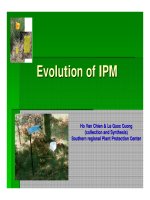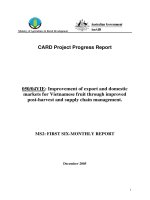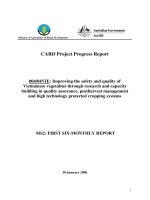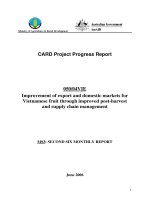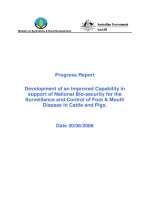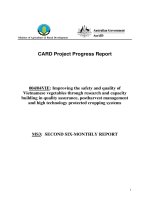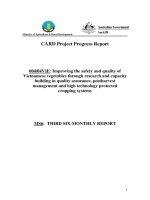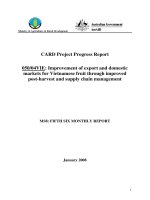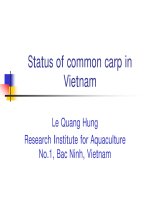Báo cáo nghiên cứu khoa học " Improvement of export and domestic markets for Vietnamese fruit through improved post-harvest and supply chain management - MS3 " ppt
Bạn đang xem bản rút gọn của tài liệu. Xem và tải ngay bản đầy đủ của tài liệu tại đây (138.68 KB, 21 trang )
Ministry of Agriculture & Rural Development
CARD Project Progress Report
050/04VIE
Improvement of export and domestic markets for
Vietnamese fruit through improved post-harvest
and supply chain management
MS3: SECOND SIX MONTHLY REPORT
June 2006
1
1. Institute Information
Project Name
Improvement of export and domestic markets for
Vietnamese fruit through improved post-harvest and
supply chain management.
Vietnamese Institution
Southern Sub-Institute of Agricultural Engineering and
Post-Harvest Technology (SIAEP)
Vietnamese Project Team Leader
Mr Nguyen Duy Duc, M. Eng.
Australian Organisation
Queensland Department of Primary Industries and
Fisheries (DPI & F)
Australian Personnel
Mr. Robert Nissen; Dr. Peter Hofman
Mr Brett Tucker; Mr. Roland Holmes; Mss Marlo
Rankin
Date commenced
June 2005
Completion date (original)
May 2008
Completion date (revised)
June 2008
Reporting period
Progress Report 1
st
Year June 2006
Contact Officer(s)
In Australia: Team Leader
Name:
Mr. Robert Nissen
Telephone:
+61 07 54449631
Position:
Project Leader
Fax:
+61 07 54412235
Organisation
Queensland Department
of Primary Industries
and Fisheries (DPI & F)
Email:
In Australia: Administrative contact
Name:
Michelle Robbins
Telephone:
+61 07 3346 2711
Position:
Senior Planning
Officer (Emerging
Technologies)
Fax:
+61 07 3346 2727
Organisation
Queensland
Department of
Primary Industries
and Fisheries (DPI
& F)
Email:
In Vietnam
Name:
Mr Nguyen Duy Duc,
Telephone:
+84 (8) 8481151
Position:
Director SIAEP
Fax:
+84 (8) 8438842
2
Organisation
Southern Sub-Institute of
Agricultural Engineering and
Post-Harvest Technology
(SIAEP)
Email:
3
2. Project Abstract
The fruit industry in Vietnam has a great potential and plays an important role in
agricultural production. In 2003, Vietnam exported US$43 million of high value fruit to
high-income countries and imported US$14 million of fruit and vegetables. Vietnam is
experiencing difficulties in competing with other Asian nations in export markets and its
own domestic market, especially with China and Thailand. This suggests that Vietnam’s
horticultural industries require substantial development to be globally competitive.
Vietnamese consumers are demanding safer and higher quality fruit. This project has
identified key pre-and post-harvest technology gaps that reduce product quality, safety
and consistency. Targeted training programs are focusing on the total supply chain and are
providing benefits by helping to implement quality management systems and GAP
systems at the village level providing greater employment for the farming community.
This project embraces the five CARD strategies for rural development; and in particular;
strategies to increase production and competitiveness of agricultural systems; reduce
poverty and vulnerability, and increase stakeholder participation whilst ensuring
sustainability.
3. Executive Summary
Baseline surveys were conducted for mango in Tien Gien and Khanh Hoa Provinces
and for pomelo in the Vinh Long Province. In total, over 120 farmers, 30 collectors
and 20 wholesalers were interviewed by the Vietnamese collaborators to obtain vital
information on how the mango and pomelo supply chians are operating.
Initial fact finding and surveys indicate that GAP, IPM and IDM issues are the largest
issues affecting fruit quality in both mango and pomelo supply chains. GAP manuals
are being developed based on current, and newly developed Asian Good Agricultural
Practice (GAP) principles. Initial drafts of manuals have been completed for Mango
Cultivation Handbook, Mango Pest Control Handbook, Mango Disease Handbook
and Pomelo Cultivation, Pest and Disease Control Handbook, and further
development of manuals is being undertaken. Post-harvest handbook for mango is
being developed in collaboration with SIAEP and SOFRI staff.
Workshops have been conducted using participatory action learning processes to
enhance the knowledge of SIAEP and SOFRI staff. Workshops were conducted on:
• developing supply chain maps on product movement, information and
monetary flows
• understanding of how supply chains function
• a strengths, weakness, opportunity and threats (SWOT) analysis
• a supply chain process analysis, that identified problems and solutions for
mango and pomelo supply chains
• developing strategic and action plans for mango and pomelo supply chains
Workshops were also held in villages with mango and pomelo growers and with
collectors to discuss supply chain maps, the SWOT analyses and strategic plans. This
4
enabled adjustment to the plans developed at earlier workshops, and to obtain support
and input from a wider cross section of farmer/growers. Information from all of these
sources was then used to develop the final industry mission statements, strategic and
actions plans. These plans were found to be in line with objectives of this CARD
Project. These objectives will be implemented during this project.
The ORID system was used to evaluate the effectiveness of the workshops. Fifty
percent of the workshop participants understood workshop concepts very well, while
the remaining 50 percent said they were satisfied with their understanding of
workshop concepts. Eighty three percent of the group indicated they would be
confident in using these concepts with other supply chains and this training fulfilled
their expectations.
Benefits to grower/farmers involvement in the workshops and training exercises has
been shown through one group been stimulated into proactively addressing and
developing new and harvesting, handling and packaging systems which improved
their first grade pack out percentage by 10%, thus providing greater scio-economic
benefits to the village and the wider community.
4. Introduction & Background
Ford et al., (2003) analysed the competitiveness of fruit industries in Vietnam and
identified poor unstable product quality, no quality standards poor post harvest
technologies and pre-harvest practices, lack of group co-operative marketing
structures and little information about supply chains, prices and customers needs.
This project addresses serious constraints through identifying key Vietnamese
stakeholders from both government and industry sectors. It engages them and
empowers them by focusing on the total supply chain network, and identify where
benefits are to be gained.
Stakeholder/beneficiary analysis conducted at project scoping and development stage
showed that mango is an important fruit crop in the Mekong Delta (33 000 ha), and in
the Khanh Hoa central coastal province (9 200 ha). Pomelo is also important in the
Mekong Delta (9 000 ha). The objectives of the project are:
• Improved pre-harvest technologies to produce high quality mango
(integrated pest management, integrated crop management, fruit fly control,
maturity indices, reduced pesticide residues, better environmental and
human health etc)
• Improved mango and pomelo post-harvest technologies (eg cool chain
management, packaging, post-harvest dipping, ethylene ripening, waxing,
washing and wetting agents, quality assurance)
• Improved quality standards and quality assurance programs for mango and
pomelo. The approach and methodologies developed for these crops
through this project will be applied to other fruits and vegetables.
5
• Mapping of current supply chains to domestic and selected export markets,
with particular emphasis on determining consumer preferences and needs,
and reporting results back to farmers.
• Provide a better understanding and possible improvements of the supply
chain by Vietnamese fruit industries for mango and pomelo.
This project will fill capacity gaps and reduce major weaknesses in pre-and post-
harvest technologies affecting product quality consistency and supply chain
management and planning. Highly specialised targeted training programs appropriate
for institutions and industry stakeholders will be provided.
At the local village and district level, cluster development of farmer/grower groups
should ensure better on-farm prices, through increased power to these
farmers/growers benefiting all members of the supply chain farmers, intermediaries to
retailers rather than the present powers brokers in the chain. Farm incomes will
therefore increase and result in better standard of living for rural and women. In
addition, if quality management systems are implemented at the village and district
level, through more appropriate fruit quality standards, packaging and grading
systems implemented. The benefits may be increase returns resulting in greater
employment at the local village level. The flow on affects of this will benefit the poor
in the rural areas, and specifically help provide more jobs for rural women.
5. Progress to Date
Implementation Highlights
Baseline Surveys
Supply chain baseline surveys were conducted by SIEAP and SOFRI staff for mango
in Tien Gien and Khanh Hoa Provinces and for pomelo in the Vinh Long Province.
Mango and pomelo production for the relevant regions revealed:
• Mango
o South East Vietnam:- 18 685ha producing 70 622 tonnes annually
o Mekong Delta:- 22 001ha producing 193 383 tonnes annually
o Khanh Hoa Province:- 5 800ha producing 18 800 tonnes annually
• Pomelo
o South East Vietnam:- 1 422ha producing 12 932 tonnes annually
o Mekong Delta:- 8 298ha producing 108 916 tonnes annually
About 20% of Vietnam’s population live in the Mekong Delta Region with 85%
living in rural areas. About 80% of rural farms range in size from 0.5 to 2ha. The
lower poverty line defined by Vietnamese General Statistics Office (GSO) is;
expenditure per capita required for securing a minimum nutritional requirement (2100
calories per day). Therefore, the poverty rate below the lower limit calculated by the
(GSO) in 2003 showed that the total poverty percentage for each Vietnamese region
where this project is operating is:
• Mekong Delta 23.7%
6
• South Central Cost 25.9%
These percentages are lower than Vietnam’s average poverty rate of 28.85 percent.
The only other region to record a poverty rate below this is the Red River Delta region
(22.4%).
The rural poverty rates have the similar trends and are:
• Mekong Delta 26.56%
• South Central Cost 31.27%
In total, over 120 farmers, 30 collectors and 20 wholesalers were interviewed by the
Vietnamese collaborators to obtain vital information on how the supply chains for
mango and pomelo are functioning in Vietnam. Surveys will be conducted at the end
of the project for further comparisons.
Survey data was presented at the first workshop during the second project trip in
April-May 2006. Information obtained was then used in subsequent workshops to
develop models of the supply chains for mango pomelo operating in Vietnam and to
develop the strategic plans for mango and pomelo.
Brief Summary of Mango Baseline Survey Information
• Total Mango area and production for the South East is 18 685 ha producing 70
622 tonnes/year, Mekong Delta Region 22 001ha producing 193 383
tonnes/year and Khanh Hoa Province 5 800ha, producing 18 800 tonnes/year.
• Vietnamese consumers regard the “Cat Hoa Loc” as the number one variety in
Vietnam.
• In the Mekong Delta, about 72% of mango fruit are transported from farm to
collector by boat, but in Khanh Hoa Province 100% are via some form of road
transport. Farmers, collectors and wholesaler believe that only 1-2% of fruit is
damaged during transport in 30 to 50 kg bamboo baskets or crates.
• In the Mekong Delta a small percentage of mango is graded at the farm level
but most fruit are graded and sorted at the collector and then again at the
wholesaler level in the supply chain. In contrast, for Khanh Hoa Province,
about 54% of farmers grade their fruit.
• In the Mekong Delta there are three basic grades, Class 1:- 420-500g, Class 2:-
300-420g and Class 3:- <300g, whilst in Khanh Hoa there are also three
grades, Class 1:- 1-3 fruit/kg, Class 2:- 4-6 fruit/kg and Beer class >6 fruit /kg.
Fruit grading is carried out by eye. Improvement and standardisation of
quality standards as well as adoption by all participants in the supply chain is
need.
• Most fruit are sold hard green, ripe fruit are not wanted.
• Collectors/farmers prefer to sell mixed grades even though the farm gate price
will be low. This is done to allow collectors/farmers to sell Class 3 fruit which
they could not normally sell. On the other hand many wholesalers find it
extremely difficult to sell Class 3 fruit. This adds significant costs to all
aspects of the supply chain and affects farmers/grower returns.
7
• Selling price for fruit:- Majority of farmers obtain the price of fruit locally.
This is achieved by asking as many collectors, farmers and wholesalers as
possible at the district level for their price paid or received for fruit sold.
• Price is usually set and established with farmers on day of sale or the day
before and based on the market supply on any given day.
• Majority of farmers do not know the price of mango at the HCMC wholesale
market.
• Wholesalers reported that most fruit will keep for 4 days with out the use of
special storage facilities. Presently there are no storage facilities located the
HCMC wholesale markets for wholesalers to use).
• At the wholesaler point in the supply chain, once the fruit is mature, for each
day that it is not sold, traders will reduce the price by 500-10 000 vnd/kg.
Brief Summary of Critical Pomelo Baseline Survey Information
• In the Mekong Delta, the Vin Long Province is considered as the leading
growing region in Vietnam for Pomelo.
• Total area and production in the Southeast is 1 422ha, producing 12 932
tonnes/year and for the Mekong Delta Region 8 298ha producing 108 916
tonnes/year.
• The pomelo variety “Man Roi” is considered the number one variety in
Vietnam.
• There are as many as 2 to 4 grades/standards of fruit depending upon market
and time of season. Each class grade standard changes, based on early season
production, mid-season and late-season production. For example, local market
there are 2 classes/grade standards, Hoang Gia Company uses 3 classes or
grade standards and the wholesale market in HCMC 4 classes or grade
standards.
• In the Mekong Delta, about 62% pomelo fruit are transported from farm to
collector by boat, and 66% transported by road to HCMC and the remainder
by boat in 80 to 85kg bamboo baskets.
• Of the total production from Vin Long Province it is estimated 5% to 6% is for
local consumption. In 2004, Metro Cash and Carry marketed 145 tonnes of
pomelo fruit. Also in 2004, 50 tonnes of pomelo was exported to Germany.
In 2005, a 100 tonnes was exported to Germany and Russia and the price was
US FOB HCMC $590USD/tonne (about 9 200VND/kg).
The CARD Project team are currently completing analysis of the baseline survey data.
Following data analysis reports will be prepared and PowerPoint presentations will be
made to Vietnamese Collaborators (SIAEP & SOFRI) and to the mango and pomelo
farmers, collectors, transporters, traders and wholesalers.
GAP Manual Development
Initial drafts of manuals have been completed. These are Mango Cultivation
Handbook, Mango Pest Control Handbook, Mango Disease Control Handbook and
the Pomelo Cultivation Pest and Disease Control Handbook. Further development
will be undertaken on these manuals. Post-harvest handbook for mango is being
developed in collaboration with SIAEP and SOFRI staff.
8
These manuals are based on current, newly developed Asian Good Agricultural
Practice (GAP) principles and will include farmer achievable improvements. These
technical manuals are being designed to be easily broken down into extension
officer’s guides and farmer/grower flip book or pocket field guides for IPM, IDM and
problem solving for the growing mango and pomelo.
Manual development and format will have the capacity to be regularly updated and
maintained. This will provide a system as farmer/grower GAP practices and
knowledge improves, they can move up to the next GAP level or step up to the next
knowledge level.
Initial fact finding and surveys indicate that GAP, IPM and IDM issues are the most
important factors affecting fruit quality in both mango and pomelo supply chains. It is
essential that these elements be corrected first before any substantial change can be
achieved though the supply chain. Participants downstream along the supply chain
cannot enhance fruit quality only maintain it with good practices and the saying
“garbage in garbage out’ is typical of any supply chain with poor quality fruit entering
the chain.
Integrated pest management (IPM) and biological control methods have been well
established in many developed countries. However, increased consumer demand for
'clean and green' products, greater understanding of occupational health and safety on
farms, and ecological and environmental issues and higher chemical costs have all
combined to highlight the need for greater IPM and IDM type practices. Vietnamese
growers must develop practical IPM and IDM systems to suit their own industry
situations and implement them to be international and domestically competitive as
well as scio-economically and environmentally sustainable.
Mango and Pomelo Industry Development
Three Australian team members travelled to Vietnam in April-May 2006 to conduct
capacity building exercises and run a series of 6 workshops. These workshops used
participatory action learning processes and capacity building for SIAEP and SOFRI
staff to develop:
• supply chain maps
• conduct a strengths, weakness, opportunity and threats (SWOT) analyse
• carry out a supply chain process analysis
• develop strategic plans for mango and pomelo supply chains for participating
CARD project members.
CARD Project members participating in these workshops were SIAEP and SOFRI
staff, farmers, collectors, traders, wholesalers and marketers etc., (see Appendix B).
All were involved in a participatory action learning process to develop the supply
chain maps, carry out SOWT analyses, develop strategic plans and participate in the
supply chain process analyse. See Appendix A for supply chain maps and SWOT
analyse.
Workshops were also held in villages with mango and pomelo growers (see Appendix
B) and with collectors to discuss supply chain maps, the SWOT analyse and strategic
plans developed at previous workshops and to adjust and obtain input from a wider
9
cross section of farmer/growers. This consultative and participatory action learning
approach is designed to empower the rural poor in the decision making processes.
Based on the agreed vision, goals and future direction for both the mango and pomelo
CARD project participants developed action plans based on the strategic plans. These
action plans for both the mango and pomelo supply chains aligned with this CARD
Project objectives. Therefore, the action plans developed indicate the project
activities for the next 2 years. Also outlined, are the reports and manuals to be
produce. These action plans, reports and manuals were discussed at the final
workshop during the Australian team visit in April-May 2006 (see Appendix C).
Strategic Planning for Mango and Pomelo Industries
Industry Mission Statements
Mango
Maintain stable incomes (prices) and consistent access to good markets by improving
pre-and post-harvest practices, QA standards, and obtain a balance between supply
chain partners, and investment in infrastructure so that consistent quality and quantity
is supplied to our customers.
Pomelo
Develop production/post-harvest and marketing practices that will provide the right
quality and quantity of fruit to our markets (export, domestic and processing),
consistently and for the long-term.
Mango Strategic Plan (Summary)
Skills &
Technology
Infrastructure Information Other
1. Improve
production process
(e.g. follow GAP)
(5i,5v)
Priority 1
3. Need handling
equipment
(coldroom,
packhouse and
transportation)
(1i,1v)
7. Need market
information for
export and
domestic markets
(4i, 3v)
Priority 3
10. Government
needs to set
standards for
maximum residue
levels
(0i,0v)
2. Ensure true
variety & improve
variety
(3i,1v)
8. Need to know
standards required
by customers
(3i,2v)
11. Government to
help with planning
and development
for specialised fruit
growing area
(2i,3v)
Priority 5
4. Improve packing
and storing
procedures
(2i,0v)
5. Need technical
support to improve
storing, packing
9. Need info
services like
internet
12. Need to
improve the
linkages between
10
and packaging
material
(2i,3v)
Combined as
Priority 4
(3i, 1v) farmers – traders –
customers.
Scientists and
government also
need to be
involved.
(4 links)
(4i,4v)
Priority 2
6. Post-harvest
handling,
chemicals and
storage
(1i,1v)
Mango Improvements under key headings with votes (i- Industry Personnel, v- Vietnamese Research
Institution Personnel): All criteria are detailed in Appendix A with votes for each criteria.
Top 5 Priority for Strategic Plan:- Listing in Order of Importance for Mango
Industry
1. Improve production process (e.g. follow GAP)
2. Need to improve the linkages between farmers – traders – customers.
Scientists and government also need to be involved.
3. Need market information for export and domestic markets
4. Improve packing and storing procedures/Need technical support to improve
storing, packing and packaging material
5. Government to help with planning and development for specialised fruit
growing area
Pomelo Strategic Plan (Summary) Domestic Markets
No WHAT
(Problems)
WHY SOLUTIONS/IMPROVEMENTS
GROWERS
1 Lack of
information &
technology on
seeds, farming
techniques, etc.
No one to contact, little
information transferred
Supporting techniques from seedling –
farming-harvesting (Guidance for GAP)
(5i,6v+2i,2v) +point 4
Priority 1
2 Lack of capital Difficult policy of loan Supporting capital/investment in
infrastructure
(6i, 0v + point 13) Priority 2
3 Advice/counsel on
standards/specifications of products
(0i, 6v) Priority 3
4
Abuse of
pesticides/chemic
als
Lack of knowledge
No guidance/ instruction
received from technicians
Training on IPM
(2i, 2v) combined with 1
TRADERS
11
12 Poor quality products Collecting from small-scale
farmers
Intensively farming & programming
production area – monoculture (1i,
4v) Priority 4
13 Weakly competitive
capability to other
traders & companies
Lack of information Investment of
infrastructure/facilities/human
resourses (3i, 0v)
Export Markets
No WHAT
(Problems)
WHY SOLUTIONS/IMPROVEMENTS
TRADERS
23 Poorly post-harvest
handling
Lack of modern technology Improving applicability of farming
techniques and technologies of
harvesting, packing and transporting.
(0i, 4v) Priority 5
Pomelo key areas with votes (i- Industry Personnel, v- Vietnamese Research Institution Personnel):
All criteria are detailed in Appendix A with votes for each criterion.
Top 5 Priority for Strategic Plan:- Listing in Order of Importance for Pomelo
Industry
1. Supporting techniques from seedling –farming-harvesting (Guidance for GAP)
2. Advice/counsel on standards/specifications of products
3. Intensively farming & programming production area
4. Training on IPM
5. Improving applicability of farming techniques and technologies of harvesting,
packing and transporting
Workshop evaluations
The ORID system was used to evaluate the effectiveness of the workshops. ORID
stands for Objective, Reflective, Interpretive, and Decisional. Both Vietnamese
industry and institute staff were surveyed at the end of our workshop and a summary
presented below.
The workbooks and materials supplied to participants and translation of these
workshops into Vietnamese showed that 55% found them very useful, while the
remaining 45% found them highly useful. Fifty percent understood workshop
concepts very well, while the remaining 50% said satisfactory. Eighty three percent
of the group indicated they would be confident in using these concepts with other
supply chains and this training fulfilled their expectations while 100% indicated they
would like further training. This will be carried out as this CARD Project enters its 2
and 3 years.
Smallholder Benefits
Each of the CARD project groups and have show greater initiative by looking for new
approaches to solving problems. A good example, is a group of mango
grower/farmers have been stimulated into proactively addressing and developing new
and improved harvesting, handling and packaging systems which resulted in improved
12
net returns last year. This provided greater socio-economic benefits to the village and
wider community. This cooperative has increased Class 1 fruit sales by 10%. New
methods for picking and handling of fruit after harvesting, packaging of fruit in
fibreboard cartons have been developed and are carried out at the cooperative level.
Fruit are marketed under this groups own cooperative trademark. This has
highlighted the benefits of have both public and private sector involvement in such
projects and how ordinary farmer’s can become leaders of change and build capacity
at the local level.
Farmer/grower and collaborators input into strategic planning and the development of
GAP pre- and post-harvest manuals is essential if adoption and implementation is to
be achieved. This is presently being undertaken and will continue as this CARD
Project progresses into years 2 and 3.
The real benefit is still to come – they are involved in identifying the problems and
the solutions they will get the training and input they need, based on their guidance
and advice, we will be working on their farms to demonstrate improved practices, we
will help tem develop high value supply chain and produce fruit to supply these
chains. That is summarised in the potential benefits documented in the action plan.
Capacity Building
Mr. Nissen, Dr. Hofman and Ms. Rankin undertook a training visit during April-May
2006 for 14 days to conduct 6 workshops. Ms. Rankin then remained for a further 2
weeks to assist the Vietnamese collaborating institutes conduct further training of
CARD project supply chain participants.
During this visit by the Australian team, a trip was also undertaken from 10:00pm till
3:00am to the HCMC Wholesalers Markets to observe fruit quality, trader operations
wholesale market operation and to discuss issues with wholesale market staff. Further
visits to Ho Loc Cooperative and Pomleo Growers and collectors were also
undertaken.
Workshop 1 was carried out to train SIAEP and SOFRI staff and to discuss processes
to be used in further workshops on strategic plan development, supply chain mapping,
supply chain process analyse, workshop evaluation methods and project action plan
development. Support and input from SIAEP and SOFRI staff on the processes to be
used to train Vietnamese supply chain CARD Project participants is essential. Their
input was vital and helped provide such highly successful training workshops.
Trainer’s workbook and workshop manuals were provided to each participant.
Workshop 2 was for the CARD project supply chain participants (grower/farmers,
cooperatives, collectors, traders, wholesalers and marketers, etc). Each workshop
participant was trained using participatory action learning methods. This workshop
enhanced their knowledge of:
• how supply chains function and develop maps of product movement,
information flows, monetary flows
• an audit of strengths, weakness, opportunity and threats (SWOT analyses) on
the supply chains
13
• develop strategic plans for mango and pomelo supply chains and this CARD
project.
Workshop 3, 4 and 5 were carried out at the village grower/farmer collector level.
Each participant was trained using participatory action learning methods. SIAEP and
SOFRI staff were trained in supply chain process analyse and conducted these process
analysis at each workshop undertaken with these groups. These workshops provide
additional training in the processes used during Workshop 2 and subsequent field
days. They were to:
• confirm the accuracy of information obtained during Workshop 2
• obtain additional information about commercial practices, quality loss etc.
• confirm whether the proposed strategic plan is accurate and appropriate
Workshop 6 was to:
• develop and discuss how to implement the relevant sections of the action plan
developed from the strategic plan
• plan the activities for the next 12 months of the project in view of the
requirements of the action plan
• discuss the required reports for the next 12 months
(See Appendix C)
Publicity
The project has received publicity through reporters Ph an Hoang and Le Hai from
Vin Long Television who were and present at the growers farmers workshop at My
Hoa village, Binh Minh District, Vinh Long Province. If possible, Vietnamese
collaborators will be asked to obtain a copy of the transcripts and hold on file for
future reference.
The CARD Project was highlighted In the Queensland Department Industries SE
Snapshot, International Scene Section, Issue 1, April 2006,. The article focused on
how the Vietnamese mango and pomelo growers are building their market supply
chain skills. How the project also aims to improve agricultural economic
opportunities for subsistence farmers in rural communities in southern and central
Vietnam and through upskilling the Vietnamese industry to achieve sustainable
change at the local level. Benefits and development opportunities also exist for
Queensland horticultural companies to form long-term partnerships with Vietnamese
communities.
Project Management
Close linkages with the joint RMIT and DPIF project staff working on Quality
Assurance Systems for ASEAN Fruit and Vegetables (QASAFV) have been made.
The QASAFV project is one of 10 projects initiated under the ASEAN Australian
Development Cooperation Program (AADCP). Exchange of information has
occurred on a regular basis. The information exchanged covered areas such as:
• product quality concepts
• development of ASEAN GAP standards
14
• supply chain development and evaluation processes
There has been no change to the project team during this reporting period.
6. Report on Cross-Cutting Issues
Environment
Many environmental issues were identified during consultation with grower/farmers
during the participatory action learning workshops. Conducting the supply chain
process analysis during these workshops issues raised were:
• contamination of irrigation water (salt and grey water)
• disposal of grey water and by product contamination of waterways
• agricultural spray application methodology and practices
• type and amount of fertiliser, their application methods to reduce
environmental contamination
• mixed farming methodology and cultural practices (mixed plant and animal
farming practices)
Poor agricultural practices can create serious problems in the Mekong Delta and
contamination of land and waterways through:
• soil management and disturbance (particularly acid sulphate soils (ASS))
• incorrect water management and irrigation systems
• incorrect and constant use of agricultural chemicals (insecticides, growth
regulators etc.)
• incorrect use of fertilisers (both organic and inorganic)
This may lead to:
• increase salinity
• decrease in productivity of crops and local aquaculture
• spread of contaminates, poisoning and increase of infectious diseases with in
the local community
• damage to the local ecology
• and loss of employment through reduced productivity
Soil Management
The soils of the Mekong Delta (area of 1.6 million ha) exhibit problems associated with
young soils. Close to 30 per cent of the Mekong Delta are of alluvial soil types, located
between the Hau Giang and Tien Giang. A further 40 per cent of the Mekong Delta is
affected by acid sulphate soils (ASS). Disturbance of ASS through land clearance,
drainage, tillage and mounding can cause acid runoffs into the aquatic and marine
environment, either killing fish or increasing the incidence of disease in the marine
population. Saline soils also present further constraints to agricultural development and
are located primarily in the coastal zone. Development of new, and re-establishment of
existing orchards, will require soil to be either moved or disturbed, and a management
plan will be needed to eliminate the runoff of acid or nutrients trapped in the soil into
the environment. These aspects should be covered as part of GAP, as their affects on
the environment could be substantial. Many farmer/growers realise the affects of their
15
present day agricultural practices and the need for change but need help. One comment
from the pomelo group was “more applied training exercises to implement GAP
principles on farm at the local level”. None of the principles on soil management have
been covered in their training to date.
Irrigation and Water Management Practices
Water has several roles to play in agricultural cropping systems. It is part of plant
structure as well as providing the transport system for nutrients and plant products
(natural plant regulators) throughout the plant. Irrigation scheduling (when and how
much water to apply) is critical and coupled with water scheduling and soil water
monitoring provides and efficient and effective use of water. Plants require water at
critical times and these are:-
• flowering and fruit set
• fruit development
• and vegetative growth phases
Therefore, monitoring of soil water is essential to eliminate excessive plant stress at
these critical times. Excessive moisture stress (drought) or over-watering can affect
cropping capacity and product quality as well as nutrient and pesticide runoff into the
environment. Good farm and orchard design is essential to ensure any runoff is
trapped on farm. This is an essential element of GAP. This element is often
overlooked or neglected due to the cost of re-establishing an orchard or loss of viable
producing area to ensure the environment is protected. There are no incentives or
subsidies and farmers/growers are forced to provide these costs out their own pocket,
reducing their viability even though there are wider social, ecological and
environmental benefits, such as reduced incidences of contractible diseases, cleaner
environment (fewer pollutants) and a healthier life for the community from such
practices.
Agricultural Chemical Usage
Ministry of Agriculture and Rural Development Department (MARD) Plant
Protection unit have documented that farmers and other pesticide users usually ignore
the risks, safety instructions and essential protective measures in using chemicals.
Records showed that 11% of all poisonings in the country are due to pesticides:
approximately 840 poisonings in 53 cities and provinces in 1999 in Vietnam. Surveys
conducted by the Plant Protection Department have shown that 80% of farmers in the
South of Vietnam consider pesticide application the essential component of the
production system compared with other control practices.
On farm chemical management involves many aspects:
• types of chemical (formulations)
• mode of action (contact or systemic)
• their availability
• purchasing (amounts and cost)
• on farm storage
• application methods
• rates of application and calculating of rates
• disposal
• safe handling and application practices
16
• withholding periods for marketing purposes
• market access issues etc
Incorrect use of pesticides in the tropics can also lead to aggravated problems in pest
control due to the year round growing season and their constant ability to develop
resistant strains faster then their counterparts in the subtropical and temperate zones.
Whilst many farmer/growers have received IPM training their application and
adoption on farm has been lacking due to compounding factors that occur at the farm
level.
Even though these environmental issues are not strictly part of this CARD project we
are providing some training on orchard design, water and soil conservation methods.
Far greater emphasis will be placed on delivering IPM and IDM methods. This will be
in consultation with our Vietnamese partners. This project aims to deliver for mango
and pomelo an assurance system that will deliver a safe clean product that meets Asian
GAP standards.
Gender and Social Issues
The project is aware of the need to incorporate, encourage and support the role of
women as project and supply chain participants in the design and implementation of
the project. At the farmer level, there have been difficulties in past projects to
encourage women to join as members of cooperatives with very few represented both
as general members and even less at a management level. This is an ongoing
challenge facing cooperative development as in general, the patriarch of the
households will join as members of the cooperative and the female member of the
household will only attend meetings if her male partner is unable. However, it has
been recognised that women play a variety of roles at all levels of both mango and
pomelo supply chains and strategies are being trialled to seek out and encourage the
involvement of women in the project.
Past experience has shown that at a farmer level, women are most likely to provide
input and participate in training when it is of a more informal nature and not overly
time consuming. Small group meetings held in members’ homes (outside of common
meal times) where female family members have been encouraged to participate have
proven to be a successful technique in drawing out opinions and gaining valuable
insight into the role they play as multi-task managers both in the home and as part of
the agricultural production activities. Book keeping is often a role taken on by
women at a farm level and many have a good understanding of fluctuating input
prices, market prices and impact on overall farm profitability. This information is
particularly valuable when attempting to analyse existing supply chains in terms of
resource flows.
Women are often heavily involved in the post-harvest marketing and sale of the fruit
also. They often represent the majority of collectors, wholesalers, traders and retailers
in both local and HCMC markets, so further upstream training should be designed to
address these roles and encourage their participation. In the recent project visit, one
particular female collector who runs a large business collecting, grading and
17
transporting fruit from southern Vietnam to central and northern markets was visited
in An Huu market and participation in the project requested. Valuable market
information and insights were gained through this visit and will be incorporated into
the analysis of existing supply chains with future collaboration encouraged.
The Vietnamese project team is also well represented with women making up the
majority of team members from SOFRI (3 of 4) and 4 female members from SIAEP
also playing key roles in project implementation. The SOFRI team is lead by
experienced scientist and extensionist Dr Hong who is committed to the professional
development of female staff. A number of young female scientists from both
institutes have been encouraged to take on key responsibilities as part of the project.
They have also been encouraged to identify, learn from and support the participation
of women at all levels of the supply chains. They have shown the capacity to
understand complex supply chain concepts and the sensitivity to recognise that
building successful supply chains requires in-depth understanding and mediation of
complex power relationships. Periodic review of project training programs, activities
and their applicability to women will be discussed with these key project personnel,
with review and adjustment to methodologies made throughout the duration of the
project.
Although the Australian project team has only one female member, her experience in
working with both farming communities and research institutes in Vietnam makes her
contribution to understanding and devising strategies to address gender issues
associated with project implementation particularly valuable. An in-depth
understanding of cultural norms and ability to work within these to encourage
participation of women in a non-threatening manner is considered critical to realistic
project outcomes that will be of benefit to women.
7. Implementation & Sustainability Issues
Issues and Constraints
At the Grower/Farmer level:
Standardised harvesting practices will be difficult to implement for both mango and
pomelo. When prices are high, grower/farmers will harvest immature fruit to take
advantage of high prices (market supply and demand curves:- high demand =
increased prices plus low supply = small quantity available). Convincing
grower/farmers to stick to standards when market prices are high and to establish a
name or their trademark or brand will be extremely difficult.
Fruit grade standards for mango will be difficult to implement, particularly when
current practices by grower/farmers who selling mixed fruit classes (Class 1 to Class
3) in the same baskets. They see quantity as the primary indicator of money returns to
farming as opposed to fruit quality being the primary indicator of increased farm
returns.
Many grower/farmers have received IPM training but found it extremely difficult to
implement and many revert back to previous practices. Training is often carried out
in other regions and no demonstrations are carried out on farms in their locality.
18
Calender spray regimes are used to control pests and diseases and these do not suite
local environmental conditions being experienced when sprays have to be applied.
All grower/farmers have experienced severe difficulties in implementing GAP.
Significant problems raised were during workshop and discussions centred on issues
such as:
• pollution of irrigation water
• intercropping (citrus and cash crops under trees)
• animals (chickens) running loose in the orchards
• difficulties in applying sprays
• fruit bats are a causing significant problems
• fruit fly is also a problem
• bacterial spot is increasing in severity and affecting more orchards each year
All growers have found that they have limited resources (capital/money) to implement
GAP and access to capital via low interest rate loans to implement GAP principles are
non existent. This makes undertaking GAP practices extremely difficult for
grower/farmers. Low returns on crops grown, and no available capital, means that
improvement will only occur at an extremely slow rate. Many grower/farmers will
remove crops that are unprofitable or difficult to manage and grow.
Expectation by grower/farmers is that handouts from the project will occur, but this is
not the case. This project is designed to build their confidence by improving their
ability through capacity building exercises to solve problems and implement solutions
that will provide increased returns.
At the collector, trader and wholesaler level:
Standardised and fruit grade standards will be difficult to maintain due to grading
being carried out by eye.
Options
Development of grade standards for both pomelo and mango will be undertaken via
consultation with grower/farmers, collectors, traders, wholesalers. Wall charts and
grade standards are presently being developed and will continue to be reviewed and
developed by this CARD Project team. Increased returns may not come immediately
as these new supply chains fight for existence with older more established chains.
Once chains establish a presence, and consumers experience superior quality product
from these chains, benefits will come (demonstrated by the Hoa Loc Mango
Cooperative which increase grade one fruit by 10%). In the future, if Vietnam joins
the World Trade Organisation (WTO), benefits may be in the form of not losing
market share to competing fruit from other countries such as Thailand, China and
Taiwan etc.
Emu Exports Vietnam are constructing a packing facility and training centre. This will
be operational by March next year in the Cam Ranh District, Khanh Hoa Province.
This facility will be have a cool and ripening rooms, line grader, packaging equipment
etc. Fibreboard boxes will be used to package mango fruit for export. The CARD
project will take supply chain participants to visit these facilities and provide training
19
on how Emu Exports Vietnam is implementing and maintain GAP principles (pre-and
post- harvest), grade standards and their supply chain to markets.
During this CARD Project training in IPM and IDM will be provided at the local
level.
• how to conduct and carry out monitoring for pest and disease
• identification of type crop damage
• identification of pest and disease causing crop damage
• when and how to spray
• on farm chemical management (as indicated above in 6 Report on Cross
Cutting Issues, Environment Agricultural Chemical Usage)
• and implementation of GAP principles
Sustainability
This project is addressing sustainability issues through
• participatory action learning process involving CARD project supply chain
participants (grower/farmers, collectors, traders, wholesalers, exporters)
section of champions or industry leaders.
• train the trainer workshops of SIAEP and SOFRI project staff who will have
capability to expand methodologies and process used in this project to other
industries
• workshops that provide information on GAP, IPM and IDM principles and
inking these to other CARD Project (Dragon Fruit) and AADCP project.
• providing background information on the benefits of health and safety,
environmental and social impacts of implementing GAP, IPM and IDM
methods in new pre- and post–harvest practices
• establishing supply chain maps for product, communication and monetary
flows, infrastructure and skills audits
• undertaking process analysis to determine problems and obtain input from
participants on solution to problems encountered in the supply chains
• undertaking baseline surveys on quality and survey to assess improvements
being implemented
If sustainability problems do arise they are being addressed by the project through
participatory action learning process and this project is making good progress in
addressing issues above. One issue of concern and highlighted by many growers and
involves financial assistance. The project team members believe that some of these
issues can be addressed through development of grower financial training project and
government assistance through special schemes set up to assist farmers implement
GAP principles.
8. Next Critical Steps
These have been grouped under the following categories based on strategic plan
priorities and are as follows:
20
• Develop and implement GAP, focussing initially on pest and disease
management (IPM)
• Improving applicability of farming techniques and technologies of harvesting,
packing and tansporting.
• Reducing post-harvest losses by establishing a demonstration of production,
sorting, packing and transport systems to provide the quality required by
selected better retail outlets
• Improve linkages between growers, traders, customers, scientists and
government also need to be involved.
• Develop high value supply chain
• Improve practices to provide high quality fruit
• Re cycle orchards as a long term plan to provide high quality fruit
For a complete breakdown of the CARD project critical steps see the Mango and
Pomelo Action Plans outlined in Appendix C.
9. Conclusion
This project is still receiving support and a high level of commitment from all the
project participants (grower/farmers, collectors, traders, wholesalers, exporters,
Vietnamese Institutes (SIAEP and SOFRI) and Australian staff involved.
Information gathering and surveys methodologies undertaken have proven to be
highly successfully in obtaining an understanding of the Vietnamese mango and
pomelo supply chains and have identifying problems areas and possible solutions.
Significant progress has been made on documenting the supply chain for mango and
pomelo and excellent progress in developing the strategic and action plans for mango
and pomelo.
SIAEP and SOFRI have committed and provided staff for implementation of the
mango and pomelo action plans and strategic plans that will ensure the objectives of
the CARD project are met.
21
